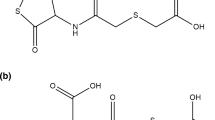Abstract
Erdosteine is a new thioderivative endowed with mucokinetic, mucolytic, and free-radical-scavenging properties. This study evaluated (in a double-blind design vs. placebo) its efficacy on biochemical and rheologic properties of sputum and on some indices of respiratory function in chronic patients with chronic bronchitis (10 per group), while receiving basic treatment with a controlled-release theophylline preparation. The pharmacokinetics of erdosteine and theophylline were also studied. We found that a 2 week treatment with erdosteine (300 mg 3 times daily) was able to reduce significantly (p<0.05) the sputum apparent viscosity, fucose content, and macromolecular dry weight (MDW) with no statistically significant influence on sputum elasticity, DNA, albumin, total proteins, total IgA, lactoferrin, and lysozyme content. The treatment caused a significant increase in the following ratios: total IgA/albumin, lactoferrin/albumin, and lysozyme/albumin. The pharmacokinetics of erdosteine, its metabolites, and theophylline were the same after 1 or 14 days of treatment, evidence both of absence of en enzymatic induction and of an accumulation process. Further confirmation that there was no interference between erdosteine and theophylline was obtained from the data available on the group of patients receiving only theophylline, since its plasma levels and related pharmacokinetic parameters were identical to those obtained in patients receiving both drugs. In conclusion, 2 weeks of therapy with erdosteine reduced the marker for mucus glycoproteins (fucose) in patients with chronic bronchitis but did not interfere with the pharmacokinetics of xanthine derivatives. We also suggest that the significant increment in the IgA/albumin ratio might be related to a sum of other local effects such as reduction of the inflammatory process and enhancement of the humoral defense mechanism.
Similar content being viewed by others
References
Biagi GL, Fregnan GB, Gazzani G, Vandoni G (1989) Erdosteine protection from cigarette smoke-induced loss ofα1-antitrypsin activity in rat lungs. Int J Clin Pharmacol Ther Toxicol 27:235–237
Croft DN, Lubran N (1965) The estimation of deoxyribonucleic acid in the present of sialic acid: application to analysis of human gastric washings. Biochem J 95:612–621
Fumagalli G, Balzarotti P, Banfi P, Decò P, Ferrante L, Zennaro M (1988) Erdosteine: a new molecule with mucolytic activity. Clinical and instrumental evaluation in patients with acute and exacerbated chronic bronchopneumopathies. G Ital Mal Tor 42:299–308
Gazzani G, Fregnan GB, Vandoni G (1989) In vitro protection by erdosteine against oxidative inactivation of alpha-1-antitrypsin by cigarette smoke. Respiration 55:113–118
Gibbons MN (1955) The determination of methylpentoses. Analyst 80:268–276
Girard F, Tourhier JM, Polu JM, Puchelle E, Beck G, Sadoul P (1981) Ultrasonic method of sputum homogenization and its application in the study of the enzymic content of sputum. Clin Chem Acta 113:105–109
Gobetti M, Pedrazzoli A, Bradamante S (1986) DL-S-(2-[N-3-(2-oxo-tetrahydrothienyl)acetamido])-thioglycolic acid: a novel mucolytic agent of the class of homocysteine thiolactone derivatives. Farmaco (Sci) 41:76–79
Lopez-Vidriero MT, Das I (1977) Airways secretion: source, biochemical and rheological properties. In: Brain JD, Proctor DF, Reid L (eds) Respiratory defense mechanisms. Part I, Marcel Dekker, New York, pp 289–356
Lopez-Vidriero MT, Reid L (1978) Bronchial mucus in health and disease. Br Med Bull 34:63–74
Lopez-Vidriero MT, Reid L (1978) Chemical markers of mucus and serum glycoproteins and their relation to viscosity in mucoid and purulent sputum from various hypersecretory diseases. Am Rev Respir Dis 117:465–477
Lowry O, Rosembroght NJ, Randall RL (1951) Protein measurement with the Folin Phenol reagent. J Biol Chem 193:265–275
Mancini G, Carbonara A, Heremans JF (1965) Immunochemical quantitation of antigens by single radial immunodiffusion. Immunochemistry 2:235–254
Medical Research Council (1965) Definition and classification of chronic bronchitis for clinical and epidemiological purposes. Lancet 1:775–779
Moretti M (1988) Proteins, deoxyribonucleic acid and ion identification. In: Braga PC, Allegra L (eds) Methods in bronchial mucology, Raven Press, New York, pp 171–188
Moretti M, Giannico G, Marchioni CF, Bisetti A (1984) Effect of methylprednisolone on sputum biochemical components in asthmatic bronchitis. Eur J Respir Dis 65:360–365
Newton GL, Dorion R, Fahey R (1981) Analysis of biological thiols: derivatization with monobromobimane and separation by reserve-phase high-performance liquid chromatography. Anal Biochem 114:383–387
Olivieri D, Del Donno M, Casalini A, Fregnan GB (1990) Effect of erdosteine on mucociliary transport in patients affected by chronic bronchitis. Respiration, in press
Prockop DJ, Davidson WD (1964) A study of urinary and serum lysozyme in patients with renal disease. N Engl J Med 270:269–274
Puchelle E, Zahm JM, Havez R (1973) Données biochimiques et rheologiques dans l’expectoration. III-Relation des protéines et mucines bronchiques avec le propriétes rhéologiques. Bull Physiopathol Respir 9:237–256
Ricevuti G, Mazzone A, Uccelli E, Gazzani G, Fregnan GB (1988) Influence of erdosteine, a mucolytic agent, on amoxycillin penetration into sputum in patients with an infective exacerbation of chronic bronchitis. Thorax 43:585–590
Scuri R, Giannetti P, Paesano A (1988) Effect of erdosteine and its metabolites on tracheobronchial mucus production and transport. Drugs Exp Clin Res 14:693–698
Sedman AJ, Wagner JG (1976) CSTRIP, a Fortran IV computer program for obtaining initial polyexponential parameter estimates. J Pharmacol Sci 65:1006–1010
Vagliasindi M, Fregnan GB (1989) Erdosteine protection against cigarette smoke-induced functional antiprotease deficiency in human bronchoalveolar structures. Int J Clin Pharmacol Ther Toxicol 27:238–241
Warren L (1956) The thiobarbituric acid assay of sialic acids. J Biol Chem 234:1971–1975
Ziment I (1978) Mucokinetic agents. In: Ziment I (ed) Respiratory pharmacology and therapeutics, WB Saunders, Philadelphia, pp 60–104
Author information
Authors and Affiliations
Rights and permissions
About this article
Cite this article
Marchioni, C.F., Moretti, M., Muratori, M. et al. Effects of erdosteine on sputum biochemical and rheologic properties: Pharmacokinetics in chronic obstructive lung disease. Lung 168, 285–293 (1990). https://doi.org/10.1007/BF02719705
Accepted:
Issue Date:
DOI: https://doi.org/10.1007/BF02719705




